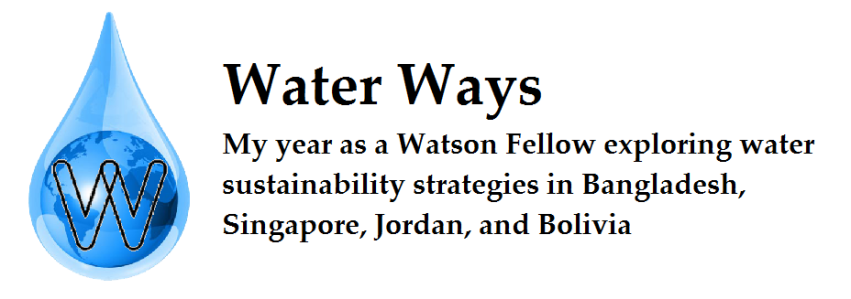Singapore (December – mid-February):
Singapore, a fascinating, urban city-state island, has no natural aquifers and a small land area (only 275mi2) to collect and store rainwater. Therefore, Singapore must rely on alternative, innovative strategies for an extended water supply, which has been led primarily by Singapore’s national water agency (PUB) over the last 50 years. They have invested significant research and funding into developing a diversified water supply known as the “Four National Taps”: (1) local catchment water, (2) imported water, (3) highly-purified reclaimed water known as NEWater, and (4) desalinated water. I want to get a closer look at each of the “taps.”
(Here is a 4-minute overview of the 4 taps.)
After ten weeks exploring Singapore’s drive towards water self-sufficiency, I am impressed and shocked that they currently have the capacity to provide 100% of their water demand. That is quite a feat considering water demand has increased twelve-fold and 75% of Singapore’s water was imported from Malaysia at the time of independence (1965). I must emphasize that Singapore became water self-sufficient in less than 50 years! Singapore went to extreme measures to make this possible. What are some extreme measures? Forcibly relocating 50,000+ people in under ten years to clean up the Singapore River. Spending billions of dollars and increasing their land area by 20% to make two-thirds of the country a water catchment. Integrating all aspects of water, waste water, and drainage under a single organization (PUB) run directly out of the Prime Minister’s office. Water is the national priority in Singapore.
If Singapore can do it, why doesn’t every country have water security?
- No agriculture in Singapore.
- Money. Singapore is a wealthy country that charges its customers to recover the cost of water and more.
- Integrated water agency. All sources of water supply, waste water, drainage, education, R&D, anything you can think of water-related is run by PUB, the National Water Agency.
- Political will. Singapore has a one-party system with strong-fisted leadership. The country was lead by the late, beloved Prime Minister Lee Kuan Yew and people would rally to his call. (In a speech, he commented that he wanted to fish in the [disgusting] Singapore river in ten years. In response, thousands of people were relocated from the river, hundreds of new high-rise buildings were constructed, a efficient transportation system developed, comprehensive urban development plan established… and ten years later he could fish.)
- City-state. Singapore only has to manage a single city – 5.5 million people and 275 square miles.
- High precipitation. Arid and semi-arid regions would not benefit from water catchment investments like Singapore.
Singapore’s situation is unique, but other countries can take away:
- Water is a product. Those who can pay for it should. (*Cough California)
- Water recycling is a good option for those with the financial resources. It is important to diversify water sources to mitigate risk.
- Political will and institutional organization are key. The technology exists for global water sustainability- the problems stem from poor policies and mismanagement.
